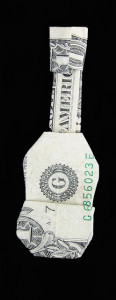I often get asked by new students and their parents, “What size guitar should I buy?” This is a great question. Although a highly motivated student will still succeed despite a guitar that is slightly too big/small, learning on a guitar that is the correct size will accelerate development by making the guitar easier to hold. A 6-year-old playing a full size acoustic guitar can look like they are wrestling and large animal and struggle to keep the guitar still while they play. This can lead to student frustration, slower development and poor technique.
The most important measurements to consider when choosing the size of your guitar are the height of the player and the scale length of the guitar which is the distance from the nut to the bridge (the length of the part of the string that vibrates). Guitar scale length ranges from about 19″ (1/4 size guitar) to about 25.5″ (full size guitar). Below is a table below to help you determine the correct size for you or your student. If the student is between sizes and still growing, choosing the larger guitar so the student can grow into it is a good idea.
Height of Player Approximate Scale Length
3’3″ to 3’9″ 19″ (1/4-Size)
3’10” to 4’5″ 20.5″ (1/2-Size)
4’6″ to 4’11” 22.75″ (3/4-Size)
5′ or taller 25.5″ (4/4-Size)

